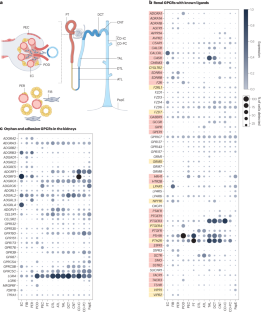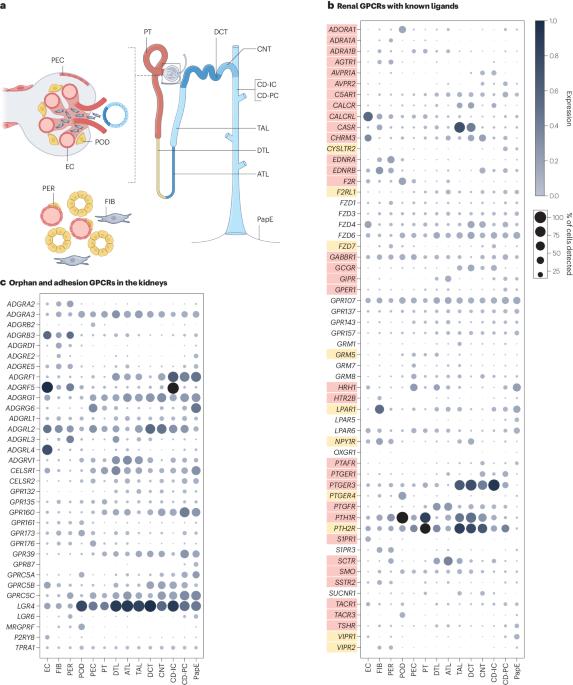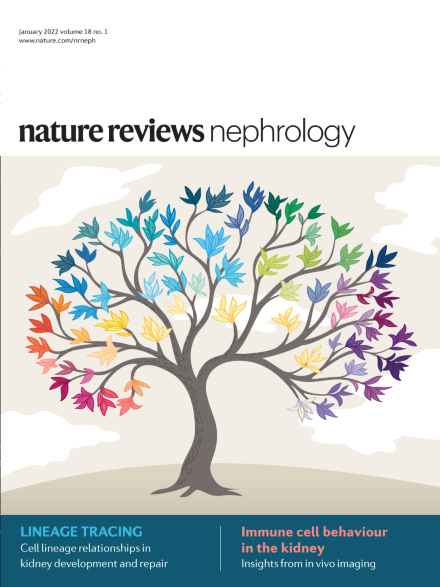Functional consequences of spatial, temporal and ligand bias of G protein-coupled receptors
IF 28.6
1区 医学
Q1 UROLOGY & NEPHROLOGY
引用次数: 0
Abstract
G protein-coupled receptors (GPCRs) regulate every aspect of kidney function by mediating the effects of various endogenous and exogenous substances. A key concept in GPCR function is biased signalling, whereby certain ligands may selectively activate specific pathways within the receptor’s signalling repertoire. For example, different agonists may induce biased signalling by stabilizing distinct active receptor conformations — a concept that is supported by advances in structural biology. However, the processes underlying functional selectivity in receptor signalling are extremely complex, involving differences in subcellular compartmentalization and signalling dynamics. Importantly, the molecular mechanisms of spatiotemporal bias, particularly its connection to ligand binding kinetics, have been detailed for GPCRs critical to kidney function, such as the AT1 angiotensin receptor (AT1R), V2 vasopressin receptor (V2R) and the parathyroid hormone 1 receptor (PTH1R). This expanding insight into the multifaceted nature of biased signalling paves the way for innovative strategies for targeting GPCR functions; the development of novel biased agonists may represent advanced pharmacotherapeutic approaches to the treatment of kidney diseases and related systemic conditions, such as hypertension, diabetes and heart failure. G protein-coupled receptors (GPCRs) elicit cellular responses to an array of stimuli to regulate the function of virtually all organs. The diverse functions of GPCRs are determined by their expression profiles and their ability to adopt different active and inactive conformations, resulting in functional selectivity or biased signalling. This Review describes the mechanisms and consequences of biased GPCR signalling with a focus on GPCRs of relevance to the kidney.


G 蛋白偶联受体的空间、时间和配体偏倚的功能性后果
G 蛋白偶联受体(GPCR)通过介导各种内源性和外源性物质的作用来调节肾脏功能的各个方面。GPCR 功能的一个关键概念是偏向信号传导,即某些配体可选择性地激活受体信号曲目中的特定途径。例如,不同的激动剂可能会通过稳定不同的活性受体构象来诱导偏向性信号传导--这一概念得到了结构生物学研究进展的支持。然而,受体信号功能选择性的基本过程极其复杂,涉及亚细胞区隔和信号动态的差异。重要的是,对于肾功能至关重要的 GPCRs(如 AT1 血管紧张素受体 (AT1R)、V2 加压素受体 (V2R) 和甲状旁腺激素 1 受体 (PTH1R)),已详细阐述了时空偏倚的分子机制,特别是其与配体结合动力学的联系。对偏性信号多面性的深入了解为针对 GPCR 功能的创新战略铺平了道路;新型偏性激动剂的开发可能代表着治疗肾脏疾病和相关全身性疾病(如高血压、糖尿病和心力衰竭)的先进药物治疗方法。
本文章由计算机程序翻译,如有差异,请以英文原文为准。
求助全文
约1分钟内获得全文
求助全文
来源期刊

Nature Reviews Nephrology
医学-泌尿学与肾脏学
CiteScore
39.00
自引率
1.20%
发文量
127
审稿时长
6-12 weeks
期刊介绍:
Nature Reviews Nephrology aims to be the premier source of reviews and commentaries for the scientific communities it serves.
It strives to publish authoritative, accessible articles.
Articles are enhanced with clearly understandable figures, tables, and other display items.
Nature Reviews Nephrology publishes Research Highlights, News & Views, Comments, Reviews, Perspectives, and Consensus Statements.
The content is relevant to nephrologists and basic science researchers.
The broad scope of the journal ensures that the work reaches the widest possible audience.
 求助内容:
求助内容: 应助结果提醒方式:
应助结果提醒方式:


